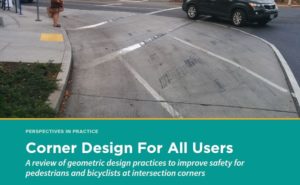 The mission of the American Society of Highway Engineers is to provide a forum for members and partners of the highway industry to promote a safe, efficient and sustainable transportation system through education, innovation and fellowship. Register here and join us at the following sessions:
The mission of the American Society of Highway Engineers is to provide a forum for members and partners of the highway industry to promote a safe, efficient and sustainable transportation system through education, innovation and fellowship. Register here and join us at the following sessions:
Corner Design for All Users
Tuesday, May 25 | 1:00 – 2:00pm EST
Historically, intersections have been designed to facilitate easy turning by infrequent design vehicles. This approach has resulted in countless intersections that are much larger than they need to be; intersections where pedestrians and bicyclists confront long crossings that leave them exposed to turning vehicle traffic moving quickly along large corner radii. This presentation makes the case, with case study examples, for a more thoughtful approach to intersection corner design as communities place greater priority on reducing serious injuries and deaths among vulnerable road users.
Speakers: Kristie Di Cocco and Nataliya Pekar
Wednesday, May 26 | 11:00am – 12:00pm EST
The Henry W. Dubois Drive corridor has become a critical connection in the New York Hudson Valley of the 750-mile Empire State Trail. Linking the Wallkill Valley Rail trail to the west and the Hudson Valley Rail Trail to the east, this section of road was the last on-road piece of the Empire State Trail between NYC and Kingston, NY. It has rolling terrain, is heavily vegetated, and yet, experiences large volumes of pedestrians and bicyclists on a roadway that is approximately 22 feet wide. The presentation will provide a brief project history and review design criteria challenges, address roadway deficiencies and the solutions developed to address stakeholder desires while meeting the technical demands of the roadway that reflects the design intent of the world-class Empire State Trail.
